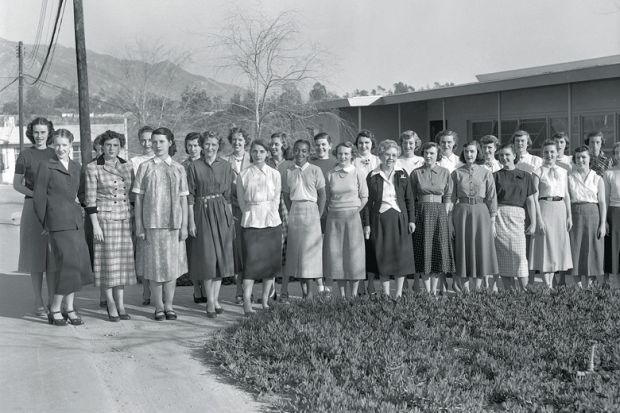They were always there.
Women making history have always existed, present in their time and thus in the archival record, although sometimes unnamed. But their stories have not always been considered significant. Nathalia Holt’s Rise of the Rocket Girls investigates the history of women at Nasa’s Jet Propulsion Laboratory (JPL) in Pasadena, California, to offer “an inside look at pivotal moments in American history from a perspective never before told”. Such compensatory histories that restore lesser-known figures to the historical narrative are only just the first step in bringing the lens of gender to analytical histories, we know. And yet, such efforts continue to be important restoratives with significant implications, in this case, for the current state of mathematics, science and engineering.
Doing women’s history presents real challenges. As Holt recounts, photos of women may have been saved but sometimes without captioning. Also, many women change their surnames when they marry, complicating research. Indeed, Holt contacted 12 different women before locating the right Barbara Lewis (Paulson), a key figure for this book. Holt’s story begins, however, with a different Barbara.
When 19-year-old Barbara Canright moved with her husband to the California Institute of Technology in 1939 and took a job as a typist, the school was still all-male. The young couple befriended the so-called Suicide Squad of incipient rocketeers – Frank Malina, Jack Parsons and Ed Forman – thus becoming two of the first employees of the newly funded Air Corps Jet Propulsion Research Project, the precursor of JPL (which would later become part of a new government agency, the National Aeronautics and Space Administration, or Nasa). As the team developed jet-assisted takeoff (JATO) devices for the US Army Air Corps beginning in 1939, Canright joined the men in the field (quite literally). As the group tested rocket motors in a dusty, dry streambed outside Pasadena, she, in stockings, heels and a skirt, recorded and processed the data. She was a computer.
Before electronic devices took over the term, a computer was a human being who computed. In Canright’s case, she calculated complex thrust-to-weight equations, repeatedly and accurately, to compile the experimental data. Armed with a high school education where she had been one of the few girls, if not the only one, in her advanced maths and science classes, she embraced the job. America’s entry into the Second World War brought more women to work alongside Canright, who was initially the only woman at JPL other than Malina’s secretary. Holt’s story reconstructs the broader history of female computers at JPL, a group eventually known simply as “the sisterhood”. At JPL, their mathematical competence coexisted with interdepartmental beauty contests in the 1950s (in some ways, a sign that there were enough women at JPL to compete) and real restrictions on their professional advancement.
The all-female computers’ enclave can be credited to Macie Roberts, the head of department after 1946. After the only male computer left during the war, Roberts hired women exclusively. She guarded her group of professional women carefully, discouraging dating at work and protecting them from untoward advances. Roberts worried that a male computer, who could advance professionally into engineering in ways that women could not, would not be content as a peer on the team. More so, however, she wanted the women’s work to be accurate and excellent. Roberts integrated the department in 1952 by hiring Jamez Lawson, whose long commute across a racially segregated Los Angeles to her new job in all-white Pasadena testified to her commitment.
Male figures in history are often written about in purely professional terms. But to flip a common slogan from the women’s movement, if the personal is political, then, for women, the professional is also personal. The realities of these women’s employment conditions – for a long time the women at JPL could not remain employed if they had a baby – meant that their professional skills were never really separate from their personal lives. Canright received weekly missives from her mother in Ohio asking her to start a family. (Indeed, in 1943, Canright left to have a baby.) In the white-collar world, even for very talented, bright, hard-working, well-educated young women, for a long time the only employment options were secretary, teacher or nurse.
The women themselves helped change those circumstances. After Helen Ling returned to work after childbirth in 1961, she rehired Barbara Paulson, who had also just had a baby. Holt interleaves the professional achievements of these working women – and then working mothers – with histories of divorce law, the Pill and the invention of pantyhose. Holt depicts women who were as comfortable with oxidisers and experimental fuels as they were with hairstyles, hemlines and childrearing. Likewise, readers of Rise of the Rocket Girls will not only meet these women but will also be introduced to hypergolic fuels, inertial guidance and gravity assists, topics inextricably woven into the women’s work.
After electronic and digital computers began to change the women’s work in the early 1950s and 1960s, JPL’s women took on computer programming and digital image processing. Their work in data reduction, finding patterns, influenced spacecraft design. Holt’s account offers a useful precis of the early history of JPL’s planetary exploration missions and the women’s contributions. By the time the women’s titles are changed to “engineer” in 1970, and some of the women start to be credited as co-authors in scholarly publications, readers understand how significant those advancements are.
One of the challenges of collective biography is not allowing the varied historical actors to blur, becoming indistinguishable or interchangeable. Holt’s highly readable account draws compelling portraits of each person. And yet, I also wanted more images of the women themselves. Holt describes various group portraits, often noting how the women presented themselves as feminine professionals, but these images are not reproduced. Archival photos of calculating machines, missiles and computing punch cards illuminate the human computers’ work, but more photos of the women throughout (in addition to the small portraits introducing early sections) would have been welcome.
Those who already know JPL’s history will find Holt’s larger story to be familiar – and indeed, the book’s notes testify to the depth of her archival research and solid command of the secondary literature. But these stories of women, taken seriously and in depth, are new and worthy of attention. The engaging stories move quickly and would even, I venture, make good beach reading.
Writing women back into the history of science and technology has profound implications, not only as a corrective to our understanding of the past but also for current practice. Take all-male conference panels (“manels”). Tumblr contributors mock them online and Canadian mathematician Greg Martin published a brilliant critique of how statistically unlikely such groupings are, given the proportion of women with PhDs working in maths. But pair those professional slights with some appalling stories of high-profile scientists who have driven competent women out of their fields through sexual harassment or even outright assault and one reveals pockets of misogynistic culture. Uncovering past female role models won’t solve those problems, but such models do begin to correct a fundamental misperception equating maths, science and engineering with masculinity.
JPL’s computers were there. They did the work and, to paraphrase the quote about Ginger Rogers doing everything that Fred Astaire did, backwards and in high heels, these ladies made their professional marks in hose and with a baby waiting at home. You’ll want to meet them.
Margaret A. Weitekamp is a curator at the Smithsonian’s National Air and Space Museum in Washington DC.
Rise of the Rocket Girls: The Women Who Propelled Us, From Missiles to the Moon to Mars
By Nathalia Holt
Little, Brown, 304pp, £20.99
ISBN 9780316338929
Published 28 July 2016
The author
 “I was born and raised in New York City, a place that I believe engendered my gritty determination but also my love of science,” says Nathalia Holt.
“I was born and raised in New York City, a place that I believe engendered my gritty determination but also my love of science,” says Nathalia Holt.
“My dad is a jazz musician and my mom was a secretary, so my steadfast pursuit of science – and I was a studious child – was an act of rebellion in my family.”
She took her undergraduate degree, in biology, at Humboldt State University in northern California. “I was 16 when I started my degree, so I was younger than most of my peers. This made me determined but also painfully naive.”
Until recently, Holt was a postdoctoral fellow carrying out research into HIV/Aids at the Ragon Institute of MGH, MIT and Harvard.
The Cambridge, Massachusetts-based medical institute is, she enthuses, “a special lab and a place that truly fosters collaboration across disciplines in science”. Holt left the Ragon to pursue a full-time writing career, following the publication in 2015 of her much-acclaimed first book Cured: The People Who Defeated HIV.
Of the research she carried out for Rise of the Rocket Girls, Holt says “there were so many surprising discoveries, but I was most shocked at how the history of these women had been forgotten. Although they worked for Nasa for 50 years, the agency had forgotten their names and contributions.
“From the first phone call I made to them, they were delighted but not surprised. I almost think they’d been waiting this whole time for someone like me to come along and finally record their memories.”
What gives Holt hope?
“Women scientists are getting far more attention now than they ever have in the past,” she says. “And I’m hopeful that the history of our current female pioneers won’t be lost to the cosmos.”
Karen Shook
POSTSCRIPT:
Print headline: From twilight to limelight
Register to continue
Why register?
- Registration is free and only takes a moment
- Once registered, you can read 3 articles a month
- Sign up for our newsletter
Subscribe
Or subscribe for unlimited access to:
- Unlimited access to news, views, insights & reviews
- Digital editions
- Digital access to THE’s university and college rankings analysis
Already registered or a current subscriber?




